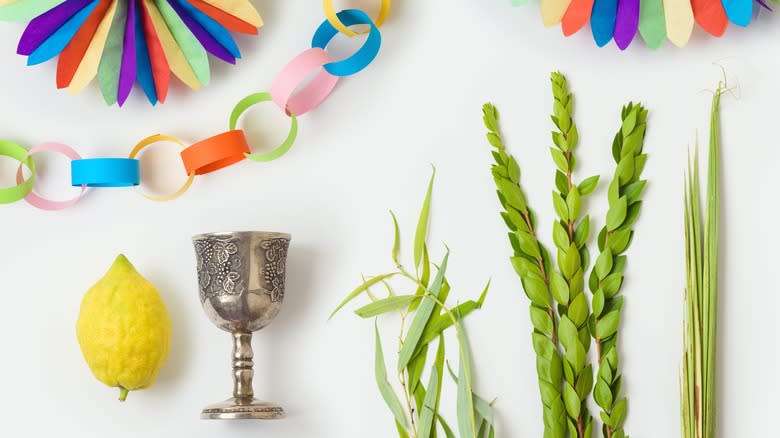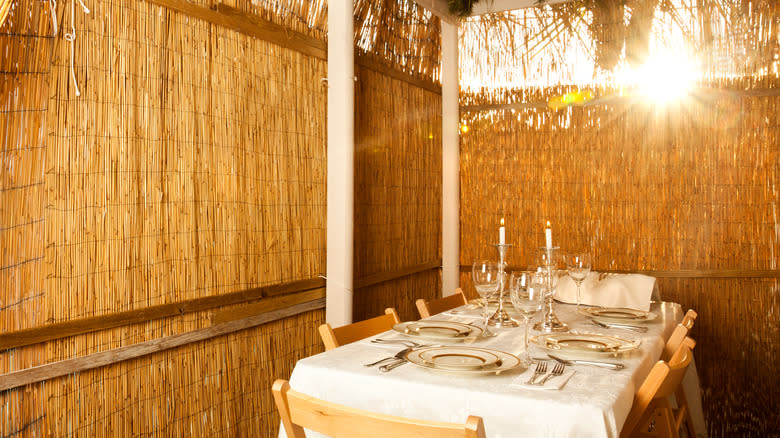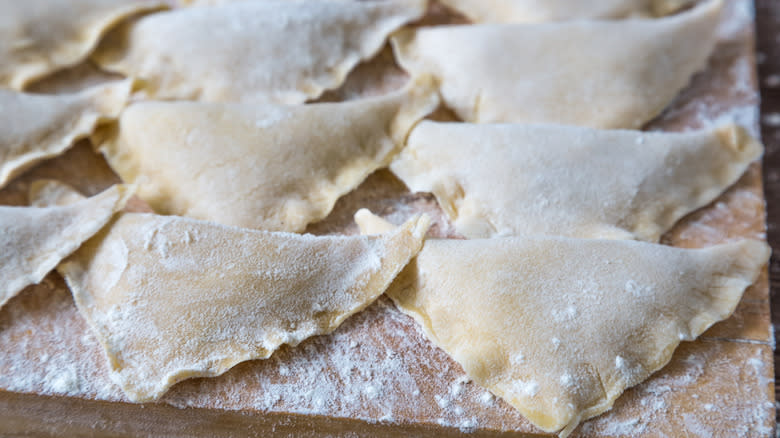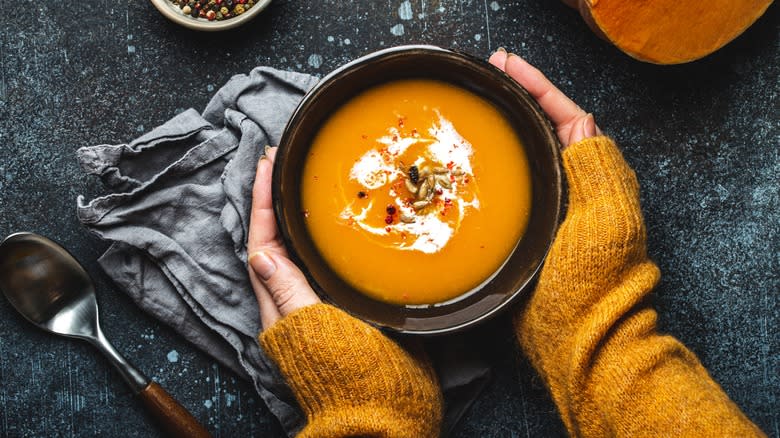8 Foods And Traditions To Celebrate Sukkot

As we flip our calendars to September, it's only natural for those who live in the Northern Hemisphere to begin thinking about autumn. While many might begin to daydream about their Halloween costume or Thanksgiving menu, there's another harvest festival just around the corner: Sukkot.
Sukkot is a relatively underrepresented Jewish festival, taking place just after the high holidays of Rosh Hashanah (Jewish New Year) and Yom Kippur (Day of Atonement). The eight-day holiday begins after sunset. Rather than a somber or serious holiday, Sukkot is a joyful yet humble celebration.
The festival of Sukkot commemorates the Israelites wandering through the desert for 40 years by celebrating privileges and everyday luxuries. The celebration includes giving thanks for shelter, the abundance of the fall harvest, the bounty of the natural world, and the joy of meal sharing with loved ones. Read on to learn about eight customary traditions and foods used to celebrate Sukkot.
Read more: Best Grocery Stores In The US
Building And Decorating A Sukkah

While most of us tend to live in buildings not built with our own two hands, this Sukkot tradition encourages everyone, no matter their skill set, to do just the opposite. It is customary for families of all ages and abilities to take a stab at building their own temporary structure, known as a sukkah.
There are various rules to what a sukkah should entail, but these are the main points: Sukkahs can have anywhere from 2 ? to four walls (the numbers stem from the numerical value of the letters of the word). They are made from natural materials, such as wood, draped fabric, and plywood; nothing needs to be sturdy. The roof of a sukkah, known as a scach, should be made from materials like branches, bamboo, and leaves and loosely constructed to allow anyone inside to look up and marvel at the stars above.
Next, it is customary to decorate the sukkah so it becomes a festive and celebratory structure. It is common to hang harvested gourds and fruits from the ceiling. People also make paper chains or other decorations made from natural materials. Once the sukkah has been erected and decorated, it is blessed and ready for use.
Eating Dinner For Eight Nights In The Sukkah

The sukkah represents temporary huts the Israelites stayed in during their 40 years wandering the desert, having escaped the oppression of slavery in Egypt. It also can represent the clouds in the sky, which would have provided respite from the brutal heat of the desert sun. Eating in the sukkah can be seen as a tribute to this period and as a symbolic gesture of gratitude for all things, including the natural world, the divine, and the food, shelter, and protection the huts provided when it was needed most.
Depending on religious involvement and local weather, families who have built a sukkah may decide to live in it or eat dinner inside for the eight nights of Sukkot. The meals, held under the stars and surrounded by thoughtfully placed, handmade decorations, help to highlight everyday delights like meals shared with loved ones and access to fresh foods and fruitful soil. Ritual or symbolic eating is a common theme throughout most Jewish holidays, from an apples and honey recipe for Rosh Hashanah to dishes like sufganiyot during Hanukkah.
Waving The Four Kinds Of Vegetation

What would a Jewish celebration be without symbolic foods and a bit of drama? We'll never know the answer. The festival of Sukkot is no different because, once you build the sukka, a few rituals take place before the eating commences.
One is to bring four symbolic plants: a citron (etrog), a palm branch (lulav), a willow (arba ), and myrtle (hadas) into the sukkah. These plants represent what is known as "the four kinds," meaning four different kinds of vegetation. They also represent a myriad of additional symbolism, from the masculine and feminine to the various sects of Judaism, to the sacredness of knowledge and good deeds. When brought together, they symbolize feelings of unity, support, community, and abundance, all relevant during the harvest season.
Each plant is waved in the cardinal directions: north, south, east, and west. The fronts are audibly shaken together, mixing with the fresh citrus smells from the etrog to create a sensory experience. This ritual also symbolizes thanks for the divine, the harvest, and the earth's ability to feed and sustain us.
Eating Stuffed Foods

During the celebration of Sukkot, it's customary to prepare and eat "stuffed foods" to be enjoyed with friends in the sukkah. While we would never turn down a reason to eat stuffed peppers, grape leaves, or cabbage rolls, these dishes are linked to ritualistic eating and not just tastebuds.
One of the reasons behind the stuffed foods, particularly vegetables, is that they represent the abundance of the harvest, much like the cornucopia does during Thanksgiving. Grape leaves were likely prominent as they remained on the vine after the grape harvest, so they were relevant to the season. Cabbage rolls, in particular, are eaten because their Hebrew name contains the same letters as the Hebrew name, meaning "blessed." Two cabbage rolls side by side might also remind some of the Torah scroll, the sacred text.
And last but not least, the holiday provides a welcome excuse to consume as much kreplach as possible. Kreplach is a traditional dumpling stuffed with meat and onions and served fried or in soup. It is an Ashkenazic dish eaten on the seventh day of Sukkot, but worth celebrating and making at any time of year.
Eating Pumpkin And Other Harvest Foods

Sukkot is a bit of a blended festival. It is recognized to commemorate the Israelites' years of wandering through the desert but also a holiday that celebrates the seasonal harvest and the abundance of the natural world, which sustained Jewish ancestors during their time in the desert. Harvest foods like gourds are not only hung as decoration in the sukkah but also enjoyed during dinners inside the temporary dwelling.
In Sephardic tradition, pumpkins have become a part of Rosh Hashanah (Jewish New Year) celebrations just before the Sukkot festival. Given the autumn season in the global north, pumpkin's presence also overlaps with Sukkot and feels only natural to include amongst the dinners and celebrations. This golden-colored gourd is known to appear in bread, soup, jam, or stew. It even appears as a pumpkin spice babka recipe! However, sweeter items would be considered a more modern interpretation. Pumpkin combines seasonality with symbolism, making it a well-loved item amongst the Sephardic Jewish community and beyond.
Sweet Potato Kugel And Tzimmis

Nothing sounds better than tucking into a warm sweet potato kugel on a crisp evening. Even better is when it's eaten in the sukkah, under the twinkling stars, and surrounded by loved ones. Sweet potato kugel is a dish that encapsulates autumn by using seasonal produce and highlights one of the more underrated ingredients when making kugels — sweet potato.
Though lokshen or noodle kugel may be the most popular, sweet potato kugels are often served on Jewish holidays, including Passover and Sukkot, and provide a lovely contrast to other dishes like brisket or roast chicken. Sweet potato kugels also make a superb vehicle for apples and cinnamon, two flavors that scream fall.
There are many other ways to incorporate sweet potato recipes. Thankfully, Sukkot provides eight nights to try them. One such way is tzimmis, a sweet stew made with roast chicken or beef, carrots, potatoes, sweet potatoes, and dried fruits. There's no wrong way to incorporate sweet potatoes into a Sukkot meal.
Challah Dipped In Honey

Challah is perhaps the most commonly used and commonly recognized Jewish food. This yeasted, slightly sweet bread appears on many Jewish holidays. Like on Rosh Hashanah, it is tradition to dip challah into honey on Sukkot. This sweet tradition symbolizes hope for a sweet new year. Honey was also thought to have sustained the Israelites in the desert before arriving at what would be considered 'the land of milk and honey.'
This dipping of the traditional bread into a highly revered product is a process that is repeated from Rosh Hashanah through to Sukkot, before concluding with Simchat Torah, where the reading of the Torah reaches the end of the scroll, and the story begins again. While there is an abundance of Jewish bakeries that sell challah specifically for this purpose, like the sukkah, there is something special about making your own challah if there is time and opportunity to do so.
Inviting Guests Over

Homebodies and those with a penchant for hosting will delight in emphasizing both qualities during the celebration of Sukkot. The festival reminds us to cherish where we live and have gratitude for our permanent dwellings rather than the temporary ones we build. It also encourages those celebrating to share their space (whether temporary or permanent) with loved ones. During the eight-day festival, hosting others for holiday entertaining and food sharing are encouraged and considered a mitzvah (a good deed).
For those who have the space to build sukkahs, inviting guests to share an outdoor meal under the structure is just about the best thing you can do to celebrate the festival. It highlights everything the holiday is about: home, harvest, food, and community. We can't think of a cozier way to welcome the transition into the colder months than a warm meal shared with friends under the sukkah with stars shining through.
Read the original article on Tasting Table.